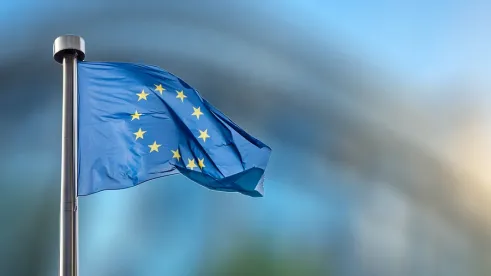The European Union (EU) has begun lifting some restrictions on non-EU travelers to the bloc, approving non-binding recommendations for member states. The United States (US), which has seen an increase in COVID-19 cases, is not among the list of countries whose citizens are permitted to travel to the EU. The United Kingdom (UK) also released updated travel guidance and similarly did not exempt the United States. The UK Prime Minister also started unveiling a post-pandemic recovery strategy this past week, with a focus on infrastructure investments. COVID-19 cases have spiked in some US states that reopened early, leading some local officials to re-impose restrictions or curb reopening plans. Meanwhile, the US Congress is also moving forward, legislatively, with new sanctions related to the Nord Stream 2 project and the situation in Hong Kong.
Reopening Updates | EU, UK, US
The European Commission is moving toward reopening the Continent. On 15 June, EU countries began to lift restrictions on travelers from other countries in the bloc; on Tuesday, 30 June, the criteria to determine whether a non-EU country is safe to allow visitors entry into the EU were established. The Council agreed and recommended that EU countries start lifting travel restrictions for residents of certain third countries. The list includes Australia, Japan, Canada, New Zealand, Morocco, Rwanda, South Korea, among other nations, but excludes visitors from the United States. The criteria for entry includes the number of COVID-19 cases over the last 14 days in non-EU countries, the country’s overall response to the pandemic, and whether cases are exhibiting a stable or decreasing trend in comparison to the past 14 days. This recommendation is not legally binding, and the list of third countries is to be reviewed on a bi-weekly basis. China will only be included on the list, if it confirms reciprocity.
As Ireland and the UK are not in the EU’s Schengen area, they are exempt from these recommendations. In addition, Denmark has special status and has been given an additional six months to implement the recommendations. This could clearly create issues, where travelers enter one member state and use it as a means to enter another, however, it remains to be seen how reopening plans will operate in practice. As the advice provided is not binding on member states, it is up to national capitals to decide whether they allow excluded countries into their territory, including citizens from the United States.
While the European Commission recommendations do not currently include the UK, the UK published its own list of ‘safe countries’ on 3 July, which largely exempts¹ visitors from these countries from its mandatory 14-day quarantine period upon arrival, effective 10 July. The Devolved Administrations (Scotland, Wales and Northern Ireland) will set out their own approach to exemptions. The UK Government also updated its global advisory against “all but essential” international travel to exempt some destinations that no longer pose an unacceptably high risk of COVID-19. The United States was not included on the list of exempted countries and travel restrictions therefore remain in place.
Meanwhile, not all EU countries have opened up their internal borders. Nordic countries, for example, are still closed to Sweden, and Cyprus retains restrictions on some EU countries including Belgium and Italy. In addition, Finland is only open to the Baltic and Nordic countries, while Denmark remains closed to Sweden and Portugal. Further to this, the Council’s recommendation that certain countries are safe to allow entry into the EU, does not necessarily mean reciprocation from those countries. For example, New Zealand Prime Minister has stated, “While the EU is looking to open its doors to a handful of countries including our own, I’m reminded New Zealanders returning from trips offshore were part of the spread of the virus in New Zealand in the first place.”
This week, Prime Minister Boris Johnson started to lay out a strategy for rebuilding and refueling economic recovery in the United Kingdom, post-pandemic. Like some policymakers in the United States, his approach includes a focus on house-building and infrastructure investments. According to 10 Downing Street, “We will invest in and accelerate infrastructure across the UK; promote a clean, green recovery; reform our planning system; and strengthen the Union and local government.” Among other things, the strategy includes establishing a new Infrastructure Delivery Taskforce, named “Project Speed,” which will work to streamline developing, designing and delivering infrastructure projects, including constructing 40 new hospitals and implementing a recently announced school rebuilding program.
This coming Autumn, the UK Government will publish a National Infrastructure Strategy that delineates its direction on core economic infrastructure, including energy networks, road and rail, flood defenses and waste. The aim is to modernize and rebalance the economy, stimulating investment and prosperity in former industrial cities in northern England, and to accelerate progress towards net zero carbon neutrality. In addition, a National Security and Investment Bill is expected shortly which will create enhanced powers for the Government to scrutinize foreign direct investment. The Prime Minister is expected to unveil more details on the strategy in the coming weeks.
The United States has several states at various levels of reopening, with others sliding back on reopening plans as COVID-19 cases have spiked. Texas and Florida, have begun reversing some of their steps intended to reopen their economies. Florida has re-closed its beaches, parks and bars in recent days and Texas has re-closed bars and limited restaurant capacity as of late last week. The nation is currently recording approximately 40,000 cases a day, or double what the country saw the first week of June. With America celebrating its Independence Day this past weekend, the COVID-19 pandemic dampened or cancelled many fireworks and large-gathering events.
Mandating the wearing of masks has primarily fallen to local elected officials to determine, with governors largely resisting state-wide mandates. Utah Governor Gary Herbert (Republican) and New Mexico Governor Michelle Lujan Grisham (Democrat) have urged Vice President Mike Pence to adopt stronger messaging that would encourage Americans to wear masks to help slow down the spread of the virus. The governors were not asking for a national mandate but were seeking a more unified message from the White House on the wearing of face coverings as states continue to struggle with how to move forward in opening their economies while trying to keep their communities safe.
Some governors have also sought to mitigate potential travel-related COVID cases. Democratic governors from New York, Connecticut and New Jersey announced this week that they have added additional states to their list of eight states announced last week who will be required to quarantine for 14 days after entering their states. This brings the total number of states on these governors’ travel advisory list to 16.² The quarantine applies to people coming from states with a positive test rate higher than 10 per 100,000 residents on a seven-day average, or with a 10% or higher positivity rate over seven days. The announcement came as COVID-19 cases are surging in many so-called “Sun Belt states³,” and ahead of the Fourth of July holiday weekend, when summer travel to the governors’ states’ beaches, parks and other attractions typically increase. New York Governor Andrew Cuomo said violators in New York will be subject to mandatory quarantine and face fines from US$2,000 to US$10,000. Massachusetts Governor Charlie Baker (Republican) also announced guidance for travelers arriving to the state – including residents returning home to Massachusetts – will require a self-quarantine for 14 days, effective 1 July. Other states also have travel restrictions in place, some specific to visitors from other US states and others specific to foreign travelers, such as Alaska, Hawaii, Idaho, Illinois, Maine, Nebraska, North Dakota, New Mexico, Pennsylvania, etc.
EU-UK Trade Talks
On Monday, 29 June, the EU and the UK launched a set of new negotiating rounds on a restricted number of sensitive areas. On the issue of a level playing field, EU Chief Negotiator Michel Barnier has stated that the EU “is ready to work on landing zones, respecting the mandate of the EU.” On the UK side, there also appears to be a willingness to come up with a solution. The Spectator magazine floated the idea of a system where the UK begins with the same rules as the EU and then would face tariff increases if they diverged.
Gibraltar continues to be another complication in the talks. Although two years ago EU countries agreed with Spain that Gibraltar should not be part of any future EU-UK trade agreement, last week the Chief Minister of the British Overseas Territory stressed the UK was negotiating on behalf of the whole of Britain, including Gibraltar. The EU has left the door open for separate deals, including with Gibraltar, which would require Spain’s prior consent. The European Parliament also express support for excluding Gibraltar from the scope of trade negotiations earlier in June.
The negotiations ended early, with UK Chief Negotiator David Frost stating that talks had “underlined the significant differences that still remain between us”. According to Barnier, serious divergences remain. A further meeting due to take place on Friday was cancelled with talks set to continue in London this coming week. Despite the fact that both sides continue to stress that a deal can be reached, German Chancellor Angela Merkel has warned that the EU should begin preparations for a no-deal scenario. In anticipation of this, the EU has updated its guidance for businesses to prepare for the end of the transition period.
US-UK Developments
The UK is overdue in establishing an agricultural trade commission to advise the Government on how to protect farmers in its trade negotiations, including those with the United States. According to UK International Trade Secretary Liz Truss, future trade agreements must be “fair and reciprocal to our farmers, and must not compromise on our high standards of food safety and animal welfare.” The commission, once established, will consider how the UK can avoid undercutting its farmers and maintain standards that reflect consumer interests. The commission would also aim to push for better standards around the world via its membership in the World Trade Organization (WTO). The UK’s National Farmers Union has reportedly been pressing the Government to set up a commission for some time, in response to fears that the UK could disregard standards in any trade deal with the United States.
On Monday, 29 June, US Department of State and Commerce officials confirmed the United States would suspend the special treatment of the Hong Kong Special Administrative Region of the People’s Republic of China under US export regulations. Exports of certain sensitive technologies will now face the same licensing requirements as those required by exporters to China. The action is the latest response to a new national law for safeguarding national security approved by the National People’s Congress regarding Hong Kong, which has enjoyed special status in its relations with the US for decades. The Administration is reportedly considering other moves to end preferential trade treatment for Hong Kong.
The US Congress also continues to work to provide additional sanctions to address the situation in Hong Kong. On Wednesday, 1 July, the House of Representatives adopted an amended version of the Hong Kong Autonomy Act, sanctions legislation originally introduced and already passed in the Senate. The Senate swiftly approved the House-passed version of the sanctions bill on Thursday, sending the measure to the President’s desk. President Trump is expected to sign the bill into law.
US-EU Developments
As briefly noted in our last report, the EU is considering potential retaliatory sanctions on the United States to protect EU businesses that are working on the Nord Stream 2 pipeline project. EU Foreign Policy Chief Josep Borrell raised this possibility in a statement, which is the EU’s strongest direct response so far on this matter. According to Borrell, “the damage inflicted on EU economic interests by American sanctions weakens transatlantic unity and the firm stance taken in regard to action by Russia, compromising and endangering Ukraine’s territorial integrity, sovereignty and independence since 2014.”
Meanwhile, during floor debate of its Fiscal Year 2021 National Defense Authorization Act (NDAA) this past week, the US Senate agreed to a package of amendments that would include a provision to impose additional sanctions on the Russia-to-Germany Nord Stream 2 pipeline. The NDAA is considered must-pass annual legislation, which must be enacted by the end of the year. The Senate has yet to formally approve its final NDAA measure, which is expected to happen when lawmakers return from a two week recess. Ultimately, any differences between the Senate and House NDAA bills will have to be reconciled. However, the provision being included in the Senate measure increases the likelihood it will be in any final, enacted NDAA.
A report published by Johns Hopkins University suggests the winner of the US presidential election in November should reverse many of the trade and defense policies the Trump Administration has pursued with Europe. The report recommends redoubling its commitment to NATO and pursuing a strategy of “safe trade”, with the aim of a US-EU agreement that lowers tariffs between the parties. The report also urges countries to commit to reforming the World Trade Organization in response to China.
________________________________
[1] Unless they have visited or stopped in any other country or territory in the preceding 14 days, arriving passengers from the exempted countries and territories will not be required to self-isolate on arrival into England.
[2] States on the list include: Alabama, Arkansas, Arizona, California, Florida, Georgia, Iowa, Idaho, Louisiana, Mississippi, North Carolina, Nevada, South Carolina, Tennessee, Texas and Utah.
[3] The Sun Belt comprises the southern portion of the United States, including the states of Alabama, Arizona, Florida, Georgia, Louisiana, Mississippi, New Mexico, South Carolina, Texas, roughly two-thirds of California and parts of North Carolina, Nevada, and Utah.







 />i
/>i
